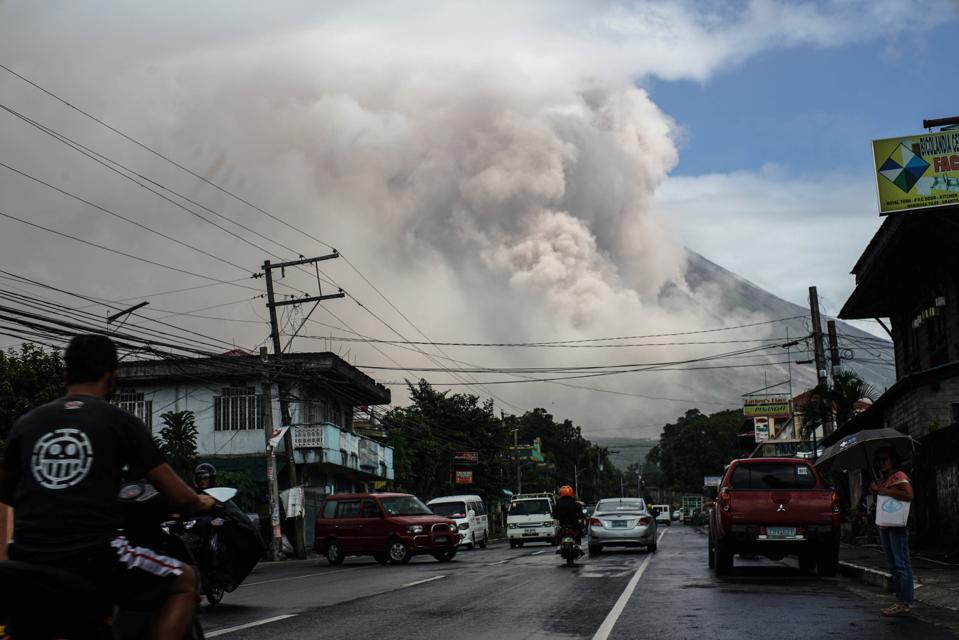
Thousands of people have fled Mount Mayon volcano as fears mount of a major eruption in the Philippines. To update you on the latest Mount Mayon news, let’s dive into the recent volcanic activity, response, and likelihood of a major eruption.
The Philippine Institute of Volcanology and Seismology reports that Mount Mayon is currently erupting fountains of lava into the air. The volcano continues to show continuous seismic activity, spewing lava, and thick ash clouds covering the area, rising 10km into the sky.

The continued increased activity of Mount Mayon has prompted the Philippine government to raise the alert level from 3 to 4, indicating that a hazardous eruption is likely imminent. In addition, the official danger zone was expanded to an 8 km radius around the active volcano.
In response, an estimated 40,000 residents (~8,300 families) have fled their homes in the Philippines for a safer location. While local authorities shut down some government operations and schools, it faces a shortage of emergency funds. The province is waiting for federal financial assistance in order to evacuate more residents and coordinate emergency management teams.

Nearby towns are being choked with ash, which has been thick enough at points to turn the daytime sky dark. This, however, it’s unexpected from the Philippine’s most active volcano. Of the nation’s 22 active volcanoes, Mayon certainly the most active, with 51 noted eruptions in the past 500 years.
LOOK: Mayon Volcano smoke resembles folklore characters ‘Panganoron’ and ‘Magayon’ hugging pic.twitter.com/D2UNwWbfPV
— CNN Philippines (@cnnphilippines) January 19, 2018
While Mount Mayon volcano is certainly capable of a major volcanic eruption, it’s unclear whether that will be the end result of this recent activity. The volcano could be simply letting off extra pressure by continually erupting at low levels as it has done in the past. Alternatively, this could be signs of an impending major eruption, as it has also done in the past. What will be key is for geologists and volcanologists to monitor the volcano for signs of continuously increased activity. A growth in the magnitude and frequency of eruptions, changes to the composition of gases and ash released, and increased seismic activity could all be indicators that a major eruption is coming.
History Of Mount Mayon Volcano
Mount Mayon is an active stratovolcano with a near perfectly symmetrical cone shape. This perfect symmetry brings in tourists to Mount Mayon in the Philippines and the surrounding national park. The volcano is located in the Albay province in the Philippines and rises 8,077 feet into the air.

The stratovolcano has a crater at the top, which is commonly produced in volcanoes after magma chambers are emptied and the overlying ground collapses. The symmetrical shape is due to a mixture of basaltic and andesitic lava flows adding layer by later to the sides of the volcano.
The volcano is a result of the Pacific Ring of Fire, produced on a large scale from the subduction of the Pacific plate underneath continental plates around its margins. Locally, however, the Philippine Sea Plate subducts underneath the Philippine Mobile Belt.

A major eruption in 1814 (VEI = 4) killed over 2,200 people and is considered the deadliest eruption Mayon’s history. While we can hope that this eruption will continue at a low level, there is a significant chance of a major eruption. A major eruption would likely result in pyroclastic lava flows, ash and pumice ejected high into the atmosphere, toxic gases, and mudflows (lahars) similar to the ones seen in California recently. A lahar occurs when mud, ash, and water mix to form a potentially deadly slurry that flows down the volcano sides.







